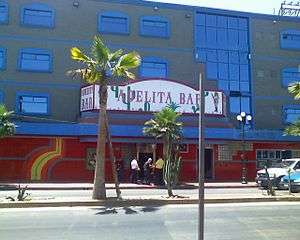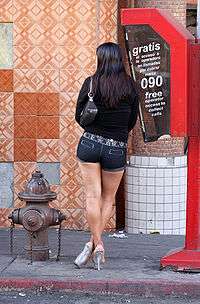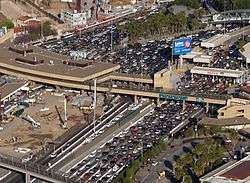Zona Norte, Tijuana
| Zona Norte | |
|---|---|
| Neighborhood of Tijuana | |
| Colonia Zona Norte | |
 Zona Norte Location within Central Tijuana | |
| Coordinates: 32°32′20″N 117°02′44″W / 32.538876°N 117.045572°WCoordinates: 32°32′20″N 117°02′44″W / 32.538876°N 117.045572°W | |
| Country | Mexico |
| State | Baja California |
| Municipality (municipio) | Tijuana |
| Borough (delegación) | Centro |
| ZIP Code | 22000 |
| Area code(s) | 664 |

Zona Norte (officially colonia Zona Norte, "North Zone (neighborhood)") is an official neighborhood as well as a red light district located in Tijuana, Mexico. It is the largest red-light district in North America known for its brothels, which present themselves in public as strip clubs and bars, similar to gentlemen's clubs in the United States. Nearly all bars and strip clubs in Tijuana's red light district in which women are the feature entertainment also operate as brothels, which offer attached hotel rooms for short intervals of time.
The red light district in Tijuana is also known for highly commercialized street prostitution, particularly behind the main strip clubs on Calle Coahuilla, in a large-high traffic alley named "Primer Callejon Coahuila". Illicit drug sales are also common to the red light district, but they occur largely out of the public eye. Due to its proximity to San Diego, California, it is frequented by US citizens as well as locals. The district is also known as La Coahuila for the name of the primary avenue that runs through it.
Location
Zona Norte is bordered by Downtown Tijuana (Zona Centro) on the south, Zona Río on the east, San Diego and the Mexico–United States border on the north, and colonia Castillo on the west. Politically, the Zona Norte neighborhood is part of the Delegación Centro (Central Borough).[1] Tijuana's red light district itself, encompasses just a couple of blocks within Zona Norte.
The unofficial boundaries of the red light district extend from Avenida Revolucion to Av. Miguel F. Martinez, east to west, and from Baja California to Calle Primera, north to south. The focal point of the red light district, however, is the core block bordered by Calle Coahuila on the north, and Primer Callejon Coahuila on the south.
Prostitution

Prostitution is permitted in Tijuana's red light district, designated a Zona de tolerancia, or "tolerance zone". Legal prostitution within the city requires sex workers to obtain a permit and be subjected to monthly health checkups.[2] Brothels in Tijuana, many of them modeled on strip clubs and hostess clubs, must also conform to certain health regulations, such as standards of cleanliness, fixed operating hours and be placed a regulated distance from schools or day-care centers.[3]
In addition to established brothels, there are prostitutes who work outside on the "callejones" or alleys and are referred to as paraditas, Spanish for "the standing girls", for the habit of standing on the streets to advertise their services. Paraditas have been regarded as part of Tijuana's cultural history, and attempts to force the women off the streets to curb such public advertising have proven unpopular and unsuccessful.[4] These street workers are either illegal prostitutes who do not have permits, or legal prostitutes who simply prefer the relatively quiet environment of the street to the loud music and smoky atmosphere of the bars.
Problems
Prostitution of children is a problem in Tijuana's Zona Norte, both in the form of voluntary acts as well as illegal child trafficking. Voluntary prostitution by children, often referred to as survival sex in order to obtain a warm meal or a place to sleep for the night is prevalent in the area. Often these children are smuggled across the border into San Diego and other nearby areas.[5]
Michael Hemmingson's ethnographic study, Zona Norte: The Post-Structural Body of Erotic Dancers and Sex Workers in Tijuana, San Diego, and Los Angeles,[6] found that many of these girls lie about their age, saying they are 19-22, and do not work the streets, but special brothels. The study suggests much of trafficking claims are exaggerated by organizations with political, moral, and religious agendas.
Young boys are also often recruited as prostitutes, sometimes as early as age 8. This forced prostitution tends to cater more to pedophiles from the United States.[7]
Illicit drug sales are prevalent in Zona Norte, and consequently there is a significant police presence there.[8]
See also
References
- ↑ "H. Ayuntamiento de Tijuana, B.C. Mexico". tijuana.gob.mx. Retrieved 25 June 2016.
- ↑ Cearley, Anna (October 11, 2004). "From the street to discreet". San Diego Union-Tribune.
- ↑ "Tijuana tries to make prostitution safer". The Arizona Republic. September 15, 2005.
- ↑ Marosi, Richard (January 23, 2005). "Prostitutes in Tijuana fight, beat City Hall". Los Angeles Times.
- ↑ Guillén, Manolo (March 5, 2006). "Trafficking in Children". The San Diego Independent Media Center.
- ↑ "study". c-s-p.org. Retrieved 25 June 2016.
- ↑ Azaola, Elena (June 2000). "Boy and Girl Victims of Sexual Exploitation in Mexico" (PDF). UNICEF.
- ↑ "U.S.-Mexico bridge proposal draws mixed reviews". San Diego Business Journal. February 4, 2002.
External links
-
 Zona Norte, Tijuana travel guide from Wikivoyage
Zona Norte, Tijuana travel guide from Wikivoyage - Zona Norte, photographs by Chris Bava, Sensitive Skin magazine #9, published December, 2012
